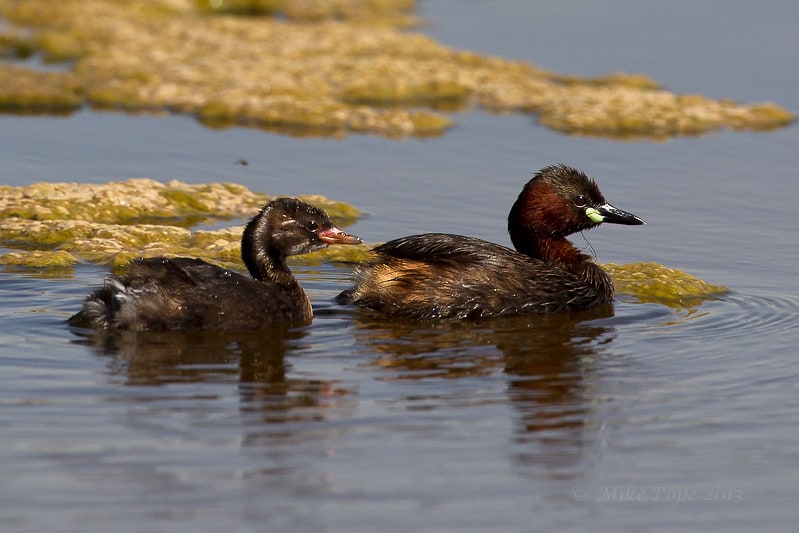Summer in Kuwait is searing hot and is traditionally a quiet birding month, however in late Spring we do have some species breeding at the Pools and mid-summer we have many Tern species breeding on the off-shore islands.
Little Ringed Plovers (Charadrius dubius) have remained through the Spring and Summer and are suspected to be breeding, but we haven’t yet found any nests
Purple Swamphens (Porphyrio porphyrio) did breed successfully this year, but the numbers have been difficult to estimate; certainly less than 10 off-spring were hatched
Little Grebes (Tachybaptus ruficollis) had a very successful breeding year at JPR

Even though it is mid-summer, birds that have completed their breeding cycles in the northern breeding grounds slowly start trickling back for the start of the Autumn migration. Initially it is the Hirundines that arrive first, so we have Barn Swallow (Hirundo rustica)
Together with Sand Martin (Riparia riparia) in the skies above the pools and occasionally roosting on the fences if the wind is blowing dust
They are followed by numbers of waders, typically Green Sandpipers and Wood Sandpipers (Tringa glareola)
and Common Sandpiper (Actitis hypoleucos) are the early arrivals
A Black-tailed Godwit (Limosa limosa) stayed a few days and stood head and shoulders above the minions
Great Cormorants (Phalacrocorax carbo) are winter visitors to Kuwait, so it was a surprise to find one enjoying the pools (even though it was being harassed by some Marsh Terns) in the middle of summer.
Finally a few birds of colour start appearing and then you feel that Autumn migration is kicking off; Blue-cheeked Bee Eaters (Merops persicus) arrive before the European Bee-eaters
Black-headed Wagtails (Motacilla f. feldegg) is the first race of Yellow Wagtail to arrive, a few in adult plumage followed by drab 1st year birds
However, you need to check all birds carefully and by doing so I found a Citrine Wagtail (Motacilla citreola), that could have easily been overlooked
Even during the heat of July, we has a handful of pretty good rarities; two Black-winged Kites (Elanus caeruleus) have been present for around 2-weeks. In Kuwait, there are less than 20 records for this species, so it does create some excitement
The 4th record of the striking Masked Wagtail (Motacilla a. personata) was another great record for JPR where it has previously been recorded and is still considered a race of White Wagtail (for now)
Even better, was the 2nd record of Indian Pond Heron (Ardeola grayii) in breeding plumage. The first was a winter bird. This bird was initially found by one of our local birders and then disappeared. I put in a few hours trying to re-locate it and finally found it roosting a way off in the reeds after the sun had set; so these are just record images of a great record for Kuwait. This bird has oiled underparts, so it has been a little spoiled – but it didn’t appear to affect the mobility of the bird


As birders our focus is predominantly on birds, but obviously any other species encountered whilst birding further enrich the outing. I came across a small bat flying over the pools in broad daylight. It was a challenge to find it in the reeds, but I finally did to discover it was a diminutiveKuhls Pipistrelle (Pipistrellus kuhlii), a species of Vesper Bat which is also known as an Evening Bat.
There is quite a variety of Dragonflies around the pools and they do make interesting subjects, even with big glass on the camera. Unfortunately there aren’t many resources available in Kuwait to help identify them – perhaps one of our contributors or readers can offer an opinion
Michael Pope
A South African ex-pat who currently resides in Kuwait with his family since October 2006 and maintains a full time job as an IT Project Manager delivering and implementing projects in Kuwait and the GCC. An avid naturalist with an interest in wildlife and conservation that started early in his schooling when he was selected to spend a week in Londolozi Game Reserve learning about Conservation and Game Ranger principals. That week had a profound impact, the seed was sown and a passion for birds, photography, wildlife, biodiversity and conservation was instilled. He has travelled and explored the length and breadth of South and Southern Africa in search of birds, Aside from birds, he photographs landscapes, mammals, reptiles and just about any living creature he can get in front of his lens. Since arriving in Kuwait has also explored many other countries expanding his list and knowledge. In Kuwait his passion for birding, photography and highlighting the need for conservation and protection of migratory birds has continued and this is showcased on his Kuwait Birding Blog http://kuwaitbirding.blogspot.com/) . In early 2008 he was proposed as and still is Chairman of Kuwait Ornithological Records Committee. However, a personal achievement of his birding tenure in Kuwait is Co-editor for the milestone publication of “Birds of Kuwait – A Comprehensive Visual Guide” in collaboration with BioDiversity East and KUFPEC.
























Leave a Reply